| H | Y | D | R | O | G | R | A | P | H | I | C | S | U | R | V | E | Y | S | |
|
|
|
|
|
|
|
|
|
|
|
|
|
|
|
|
|
|
|
|
 |
 |
 |
 |
 |
 |
 |
 |
 |
 |
 |
Hydrographic Surveys Completes Submerged Oil Dragging Procedure
March 2, 2005
Sewell, NJ - Hydrographic Surveys has recently completed "mopping" operations at two ship berths on the Delaware River
using specifications provided by the New Jersey Department of Environmental Protection. Having developed a comprehensive
procedure and a combination of custom fabricated and off-the shelf-materials, Hydrographic Surveys was able to certify two
ship berths as free of residual oil deposits for upcoming dredge projects.
The Submerged Oil Dragging Procedure was developed by NJDEP in response to concerns about dredge materials possibly
becoming contaminated with residual oil deposits from the November 2004 oil spill on the Delaware River. The procedure calls
for dragging viscous snare material over the top of sediments in the proposed dredge area. This material is gathered in small
bundles called ‘pompoms’ and attached to a weighted beam which is then submerged to contact the bottom. The beam is held
perpendicular to the direction of travel, such that a continuous area of coverage the length of the beam is created. After each pass
of the mopping beam, it is raised and inspected for any trace of residual oil deposits. Photographs are taken and the condition of
the sorbent materials are recorded. If residual oil is detected, the contaminated materials are removed and replaced with new
‘pom-poms’ and the procedure is repeated until no oil is detected.
Hydrographic Surveys responded to a request on February 24, 2005 by Weston Solutions, of West Chester, PA, to provide a
towing vessel and all associated equipment to complete "mopping" work on the Delaware River. In just five days from notification,
using resources and expertise related to similar projects, Hydrographic Surveys was prepared to complete the work on
March 1, 2005. Some of the hurdles which had to be overcome to complete this task included redeploying the survey vessel
‘Michele Jeanne’ from Elizabeth, NJ to Gloucester, NJ, developing a comprehensive operations and safety plan, and fabricating the
beam and necessary components for lifting and dragging operations.
Submerged Oil Dragging Procedure – Delaware River Berths
Time Requirement
•
Dragging must begin at most 2 weeks prior to the dredging operations unless special circumstances such as vessel traffic orweather prevent commencement in which case, specific permission must be obtained from NJDEP.
General Description:
•
Prior to dredging, a dragging of sorbent material atop sediments to detect residual oil deposits from the November, 2004 oil spill.•
A towing vessel dragging a weighted mopping beam aligned perpendicular to the direction of travel.•
Towing vessel traveling along parallel transects within the area to be dredged using a DGPS navigation system with data loggeraccurate to +/- 1 meter.
•
Sorbent pom-poms in sufficient number, attached to the mopping beam to ensure continuous coverage along the mopping beam.•
Towing cables or chains of adequate strength and length to ensure the mopping beam remains in contact with the river bottomduring dragging.
Performance Criteria
•
The dragging vessel shall proceed at no more than five (5) knots.•
At a minimum, the transect spacing should be as wide as the towing vessel’s mopping beam such that there is a reasonableattempt to make contact with all areas to be dredged.
•
The mopping beam transects should extend so mopping occurs at least 25’ outside of the area to be dredged, if accessible.•
After each pass, the mopping beam shall be completely removed from the water and inspected.•
The condition of the pom-poms (no oil, lightly oiled, heavily oiled) and type of oil (black oil, medium/#2 oil or light oil), ifencountered, shall be noted for inclusion in the Field Report.
•
Photos will be taken when oil is present and/or before the pom-poms are discarded.•
If oil is encountered, clean pom-poms shall be attached and the same transect path shall be dragged again to determine if oil hasbeen removed or if additional oil is present.
•
If significant operational hindrances are encountered due to trash, debris, or other unforeseen physical obstacles, environmentalor time constraints, the operation can be modified in the field to adapt to these hindrances, including modifications to transect
spacing and coverage area as long as a diligent and reasonable effort is made to "mop" the greatest area possible under the given
conditions.
Data Logging and Field Report should include:
•
Berth name and date(s) of dragging operations.•
Time of each transect run and an index number assigned to each transect run.•
Description of the condition of the pom-poms correlated with each transect run.•
Photos of pom-poms will be included in Report and correlated to respective transect run.•
An AutoCAD drawing (or equivalent) of the berthing area including major features (piers, bulkheads).•
The recorded vessel position at a minimum of 5’ intervals along traveled field transects as recorded by the vessel’s electronicpositioning system, including the corresponding depth. Transects indexed as referenced in the Field Report.
•
Signature of the person with responsibility for the dragging operation to include a statement as to the integrity of the Report•
Field Report Submitted to NJDEP Office of Dredging and Sediment Technology.
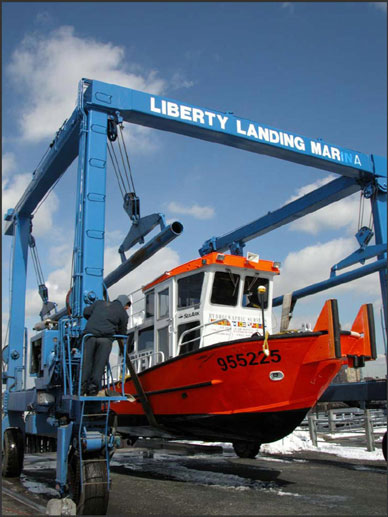
Preparing to Re-Deploy
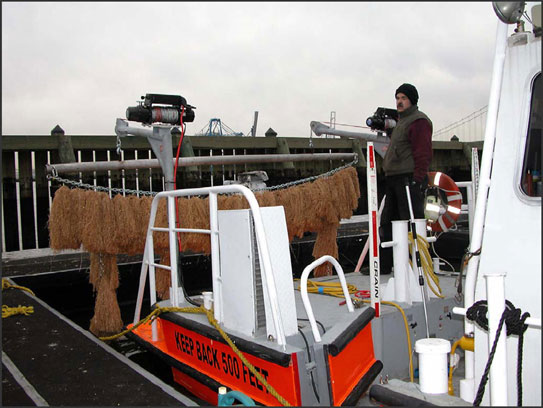
Completing installation of winches and lifting tackle at Riverside Marina, Gloucester, NJ.
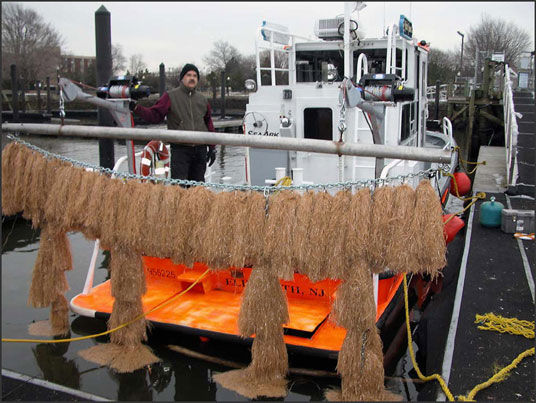
Completed rigging and dragging bar, with viscous snare material attached.
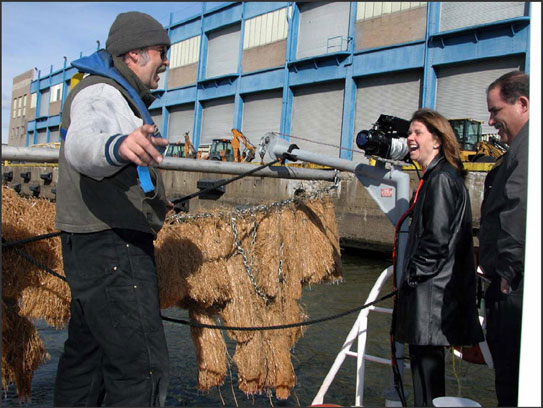
Explaining methods and procedures to representatives of Philadelphia Regional Port Authority.

Condition of viscous snare material being documented after each pass.

Sonny Rutkowski, Weston Solutions, examines and photographs sediment from mopping.
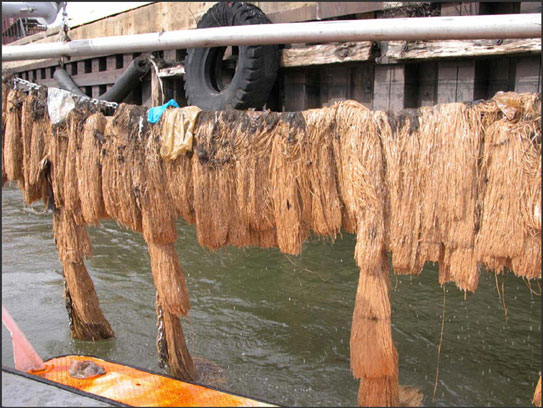
Typical Sediment and Debris, no oil present.
Copyright © 2005 Hydrographic Surveys.